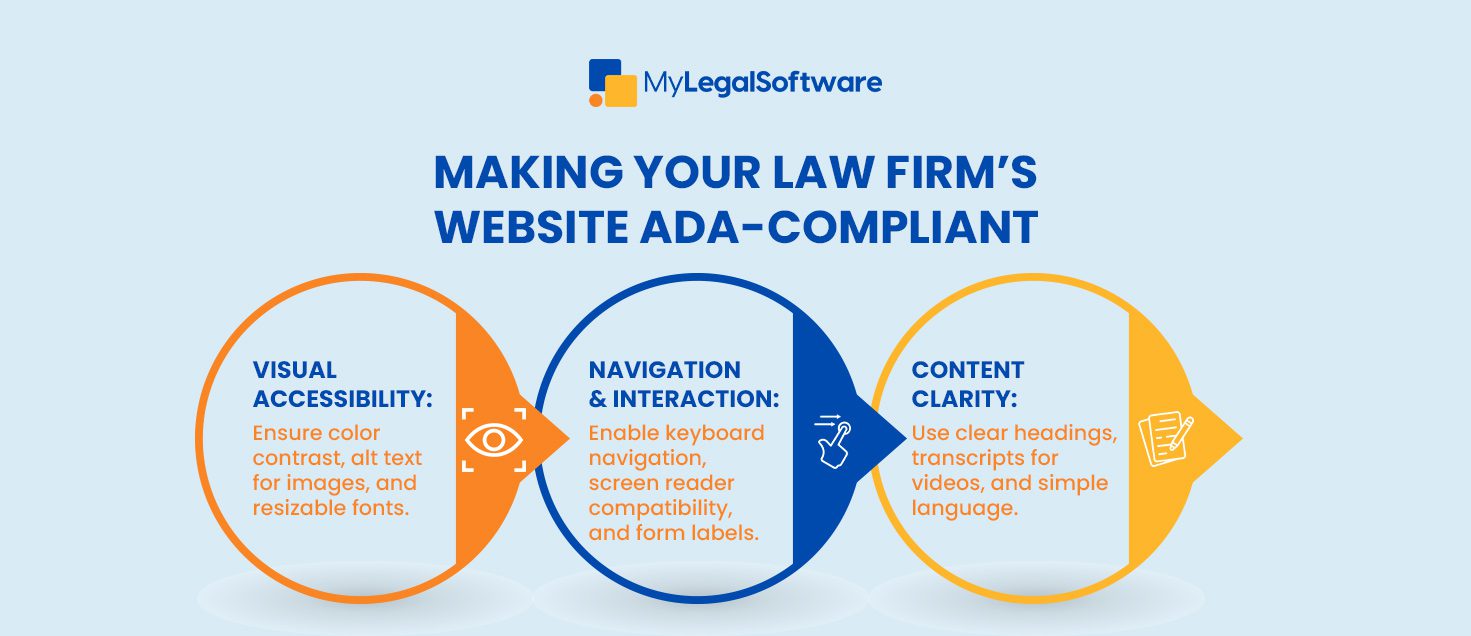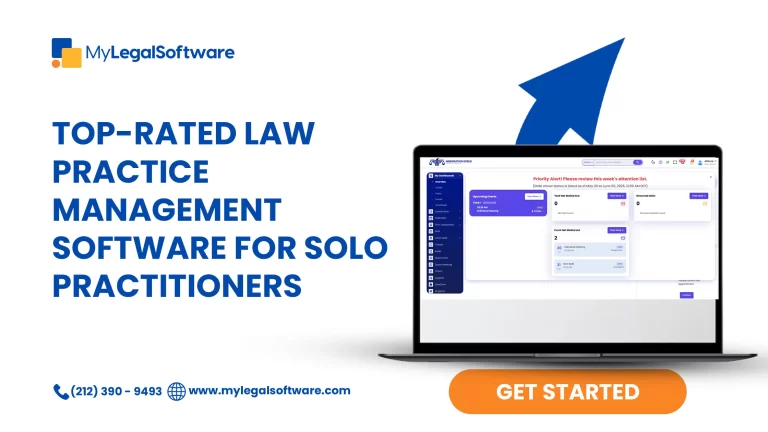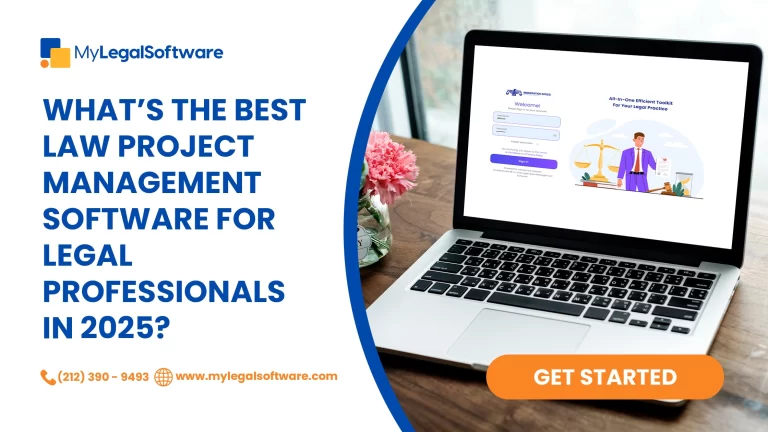Think about this, a disabled person approaching a Immigration law firm’s office, but the doors are too heavy to open, the signage is unclear, and there’s no wheelchair ramp in sight. Frustrating, right? Now, think about the digital equivalent – an inaccessible legal website. Many law firms unknowingly create barriers for individuals with disabilities, making it difficult for them to navigate and use their services. That’s where ADA compliance comes into play.
Ensuring your firm has an ADA-compliant website isn’t just about avoiding lawsuits – it’s about legal compliance, inclusive design, and reaching a broader audience. Plus, having a user-friendly navigation benefits everyone, making your legal website accessibility a top priority. Let’s dive into the details of ADA Compliance and why it is essential for your law firm’s website.

Understanding ADA Compliance and Web Accessibility
The Americans with Disabilities Act (ADA) was enacted in 1990 to prevent discrimination against people with disabilities. While the ADA was initially geared toward physical spaces, courts and regulations have increasingly applied it to digital platforms.
In essence, an ADA-compliant website ensures that individuals with disabilities – such as visual, hearing, and mobility impairments – can access and navigate your site effectively. A lack of legal website accessibility could lead to legal trouble and, more importantly, exclude potential clients.
What are the Web Content Accessibility Guidelines (WCAG)?
The Web Content Accessibility Guidelines (WCAG) serve as the gold standard for web accessibility. These guidelines focus on four key principles:
- Perceivable: Content should be presented in a way that all users can perceive, such as text alternatives for images.
- Operable: Website functionalities must be accessible via keyboard navigation.
- Understandable: Information should be clear and readable.
- Robust: Your site should be compatible with assistive technologies like screen readers.
Failing to meet these standards could lead to accessibility lawsuits, particularly under the ADA Title III, which mandates equal access to public accommodations.
The Legal Risks of an Inaccessible Immigration Law Firm Website
Ignoring legal website accessibility can be a costly mistake. Law firms across the country have faced lawsuits for failing to maintain an ADA-compliant website. A legal case could damage your reputation, drain resources, and ultimately drive away potential clients.
Some common accessibility violations include:
- Lack of text alternatives (alt text) for images.
- Poor color contrast, making it difficult for visually impaired users.
- No captions for audio or video content.
- Non-keyboard accessible navigation.
By investing in law firm web development with accessibility in mind, you can prevent these issues while demonstrating a commitment to inclusivity and equal access.
How ADA Compliance Benefits Your Immigration Law Firm
Beyond avoiding legal consequences, making your website ADA-compliant comes with several benefits:
1. Expands Your Law Firm’s Client Base
According to the CDC, one in four U.S. adults lives with a disability. By ensuring legal website accessibility, you’re tapping into a significant portion of the population who might need your legal services.
2. Enhances SEO and Search Rankings of Immigration Law Firm Website
Search engines favor inclusive design. Accessible websites often rank higher on Google, improving visibility and bringing in more organic traffic. Features like alternative text, transcripts, and clear navigation improve both accessibility and SEO.
3. Builds a Positive Reputation
A Immigration law firm that prioritizes accessibility showcases its commitment to serving all clients fairly. Word spreads fast, and an inclusive approach can enhance your firm’s reputation and credibility.
4. Improves Overall User Experience of Immigration Law Firm Website
Good law firm web development benefits all users. A well-structured website with user-friendly navigation not only helps people with disabilities but also enhances the experience for all visitors, leading to higher engagement and conversions.
Practical Steps to Make Your Legal Website ADA-Compliant
1. Use an Accessibility Audit Tool
Start by evaluating your website using accessibility audit tools like WAVE, Axe, or Google Lighthouse. These tools can help identify accessibility gaps and suggest improvements.
2. Ensure Keyboard Navigation
Users should be able to navigate your site without a mouse. Test keyboard accessibility by using the Tab key to move through your website and ensure all elements are reachable.
3. Add Alternative Text to Images
Alt text provides descriptions for images, allowing visually impaired users who rely on screen readers to understand the content.
4. Provide Captions and Transcripts
For multimedia content, include captions for videos and transcripts for audio files. This ensures users with hearing impairments can still access your content.
5. Improve Color Contrast and Font Readability
Make sure text stands out against the background, ensuring clarity for users with visual impairments. Avoid small fonts and choose readable typography.
6. Use Accessible Forms and Labels
Ensure all online forms include proper labels, error messages, and clear instructions for users with disabilities.
7. Enable Resizable Text
Users should be able to resize text without breaking the website’s layout or losing functionality.
8. Regularly Test for Compliance
Accessibility is an ongoing process. Regular testing, updates, and staying informed about new regulations will keep your website compliant.
Conclusion
Creating an ADA-compliant website isn’t just about meeting legal requirements—it’s about fostering inclusive design, ensuring user-friendly navigation, and making your legal services accessible to everyone. A website that prioritizes legal website accessibility improves SEO, enhances user experience, and protects your firm from potential lawsuits.
Ready to make your law firm’s website fully accessible? Let MyLegalSoftware help you implement the necessary changes and keep your site compliant. Visit MyLegalSoftware.com today to get started!
Want to learn more about Cost-Effective Legal Staffing Solutions for Growing Immigration Law Firms? Click here.
Frequently Asked Questions
1. Why is ADA compliance important for my law firm’s website?
ADA compliance ensures that your website is accessible to individuals with disabilities, preventing legal risks and expanding your client base. It also improves SEO and enhances overall user experience.
2. How can I check if my law firm’s website is ADA-compliant?
You can use accessibility audit tools like WAVE, Axe, or Google Lighthouse to check for compliance issues. Additionally, testing your site’s keyboard navigation, contrast, and text alternatives can help identify potential accessibility gaps.
3. What happens if my website isn’t ADA-compliant?
Non-compliance can result in lawsuits, fines, and reputational damage. More importantly, it excludes potential clients who may need your legal services. Making your website accessible benefits both your firm and your audience.








